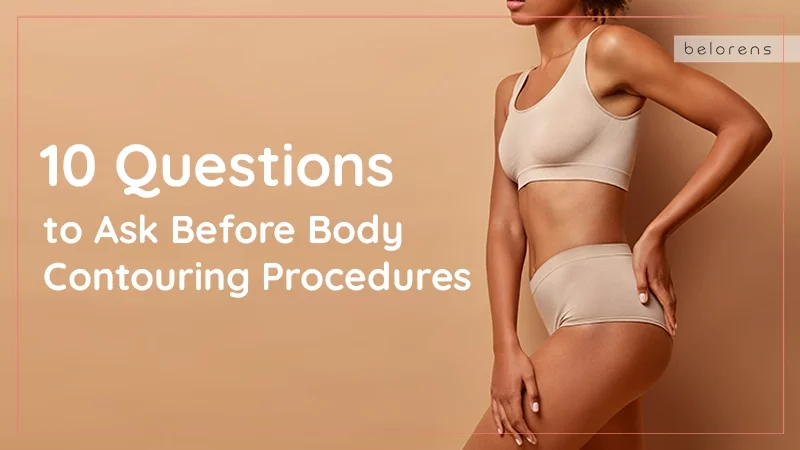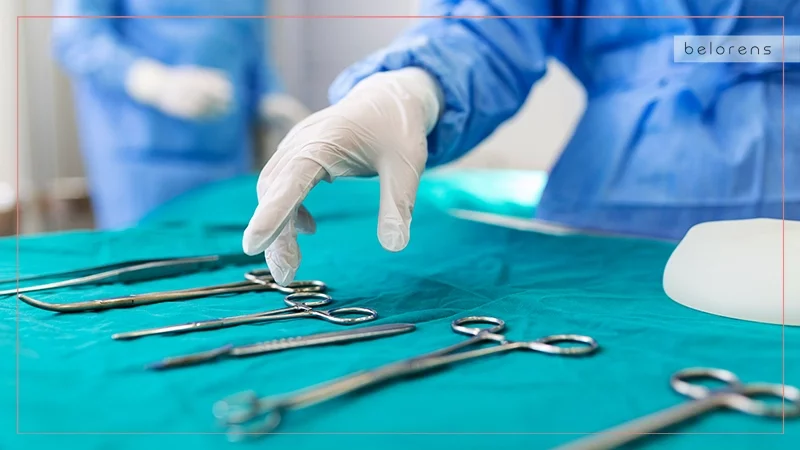Published on 26 June 2024 | Last updated on 14 Oct 2024
10 Questions to Ask Before Body Contouring Procedures
- ByMedical Content Team
- Medically Reviewed byDr. Sabine Kulhanek
Fact checked

- What are my goals for body contouring?
- Am I a good candidate for body contouring?
- What are my options?
- What are the risks and potential complications?
- What is the surgeon's experience with body contouring procedures?
- What is the recovery process like?
- How long will the results last?
- What kind of anesthesia will be used?
- Are there any non-surgical alternatives?
- What is the surgeon's revision policy?
- Last word
Body contouring procedures have become increasingly popular as people seek ways to enhance their appearance and achieve their desired body shape. Whether it's through liposuction, tummy tucks, or non-invasive treatments like CoolSculpting, these procedures can offer transformative results. However, the decision to undergo body contouring is significant and requires careful consideration.
Before committing to any cosmetic surgery, it's crucial to be well-informed about the process, potential risks, and what you can realistically expect. Asking the right questions not only helps you understand the procedure better but also ensures you select the right surgeon and approach for your needs.
Whether you're considering a subtle tweak or a major transformation, being well-prepared is the key to making the best decision for your body and your confidence. Below are some of the essential questions you should ask before deciding on a body contouring procedure. These questions will help you clarify your goals, assess your suitability, explore your options, and prepare you for a safe and satisfying journey toward achieving your desired look.
What are my goals for body contouring?
Understanding and clearly defining your goals for body contouring is a crucial first step in the process. This question helps both you and your surgeon determine the best approach to meet your expectations and achieve your desired results.
First, think about your aesthetic goals. Identify the specific areas of your body that you want to improve. Common areas include the abdomen, thighs, buttocks, arms, and neck. Being specific about these areas helps the surgeon understand where to focus. Also, describe the changes you wish to see. Do you want a flatter stomach, more defined arms, or lifted buttocks? Clearly communicating your desired outcomes is essential for effective planning.
Next, consider your motivation. Reflect on why you want to undergo body contouring. Are you looking to boost your self-confidence, enhance your appearance after significant weight loss, or address changes from pregnancy and aging? Setting realistic expectations about what body contouring can achieve is important. Discussing your goals with your surgeon ensures they are attainable and helps you understand the limitations of the procedures.
Think about your long-term goals as well. Consider how the results will fit into your long-term lifestyle. Are you committed to maintaining a stable weight and a healthy lifestyle to sustain the results? Also, consider any future plans that might affect your body, such as pregnancy or significant weight changes, and how they might impact the longevity of your results.
Finally, ensure you are mentally prepared for the changes. Body contouring can have a significant impact on your appearance and self-esteem, so being mentally ready for the transformation is just as important as the physical preparation.
Am I a good candidate for body contouring?

Determining whether you are a good candidate for body contouring involves evaluating various factors related to your health, lifestyle, and expectations. First, assess your overall health. Ideal candidates are generally in good health without any serious medical conditions that could impair healing or increase the risks of surgery. It’s important to discuss your medical history with your surgeon, including any chronic illnesses, medications, and previous surgeries.
Next, consider your skin elasticity. Successful body contouring often depends on the skin’s ability to contract and conform to new contours. If you have good skin tone and elasticity, your results are likely to be better. However, if you have significant sagging or loose skin, additional procedures such as skin tightening might be necessary.
Your weight stability is also crucial. Candidates should ideally be at or near their goal weight and have maintained a stable weight for at least six months. Body contouring is not a weight-loss solution but rather a way to enhance body shape and remove stubborn fat deposits. Significant weight fluctuations after the procedure can affect the results.
Additionally, consider your commitment to a healthy lifestyle. Maintaining the results of body contouring requires a balanced diet, regular exercise, and overall healthy habits. Candidates who are committed to these lifestyle changes are more likely to sustain their results in the long term.
Lastly, evaluate your mental readiness. Undergoing body contouring is a significant decision that requires careful consideration. Make sure you are mentally prepared for the changes in your appearance and the recovery process.
Also Read: 5 Tips to Maintain Liposuction Results for Long
What are my options?
Knowing your options for your body contouring procedure enables you to have a more informed discussion with your surgeon and set realistic expectations. There are several body contouring options, each designed to address different concerns and areas of the body. Surgical options include procedures like liposuction, tummy tuck, body lift, arm lift, and thigh lift, which involve removing excess fat and skin to enhance body shape. Non-surgical options, such as CoolSculpting, use techniques like controlled cooling to reduce fat without invasive surgery.
Discussing these options with your surgeon helps determine which procedure or combination of procedures is most appropriate for you based on your specific goals, body type, and medical history. This conversation also allows you to understand the benefits, risks, recovery times, and potential outcomes associated with each option, ensuring you make a well-informed decision tailored to your individual needs.
Also Read: How Are Liposuction and Tummy Tuck Different?
What are the risks and potential complications?
Understanding the risks and potential complications of body contouring procedures is essential before deciding to undergo surgery. This question ensures that you are fully informed about what to expect and can weigh the benefits against the risks.
Like any surgical procedure, body contouring carries general risks such as infection, bleeding, adverse reactions to anesthesia, scarring and poor wound healing, blood clots, and fluid accumulation. These can vary based on the specific procedure and individual health factors. Additionally, Each body contouring procedure has its unique set of risks. For example, liposuction can cause contour irregularities, while tummy tuck can lead to muscle weakness or damage.
By asking about the risks and potential complications, you can better prepare for surgery and make an informed decision. It also allows you to discuss your concerns with your surgeon, understand the steps they take to minimize risks, and know what signs to look for during recovery that might indicate a complication. This knowledge is crucial for ensuring your safety and satisfaction with the results.
What is the surgeon's experience with body contouring procedures?

A surgeon’s experience and expertise significantly impact the outcomes of body contouring procedures. Experienced plastic surgeons are more likely to have refined their techniques, understand the nuances of various procedures, and manage complications effectively.
It is crucial to do research into the surgeon’s experience of body contouring procedures. Knowing the number of procedures a surgeon has performed can give you a sense of their experience level. More procedures typically indicate a higher level of expertise. Additionally, surgeons who specialize in body contouring are likely to be more skilled and knowledgeable about the latest techniques and best practices. Inquire about any specialized training or continuing education the surgeon has completed in body contouring techniques.
Reviewing before-and-after photos of the surgeon’s previous patients can also help you assess the surgeon’s skill and the consistency of their results. Look for patients with similar body types and concerns to yours. Additionally, board certification ensures that the surgeon has undergone rigorous training and meets high standards of practice in plastic surgery.
By thoroughly discussing the surgeon’s experience and qualifications, you can make a more informed decision and feel more confident in your choice of surgeon. This step is crucial for achieving the desired outcome and ensuring your safety throughout the process.
Also Read: Aesthetic Medicine: Specialties That Offer Cosmetic Solutions
What is the recovery process like?
Knowing the details of the recovery process allows you to make a fully informed decision about whether to proceed with the surgery. It helps you weigh the benefits against the potential downtime and discomfort associated with recovery. It enables you to prepare adequately, including arranging time off work, organizing help with daily activities, and setting up a comfortable recovery space at home.
Recovery from body contouring procedures can involve significant discomfort. By asking about the recovery process, you can learn about the expected pain levels and the pain management strategies your surgeon will provide, ensuring you are prepared to handle post-operative pain effectively.
Different procedures come with varying levels of activity restrictions during recovery. Knowing these restrictions in advance helps you plan your physical activities and avoid actions that could impede healing or cause complications.
Recovery typically involves multiple follow-up appointments to monitor your healing and address any concerns. Knowing the frequency and importance of these visits ensures you stay committed to your post-operative care plan.
The recovery process can be emotionally challenging. Being aware of what to expect helps you mentally prepare for the changes in your body, temporary discomfort, and the time it takes to see the final results. This knowledge can alleviate stress and anxiety during recovery.
In summary, asking about the recovery process is essential for ensuring you are fully prepared for what lies ahead. It allows you to plan effectively, manage your expectations, and take the necessary steps to support a successful and smooth recovery.
How long will the results last?

Asking about the longevity of the results before undergoing body contouring procedures is crucial for several reasons. Understanding the longevity of the results helps set realistic expectations, informs your decision-making process, and prepares you for the commitment required to maintain your new look.
Knowing how long the results are likely to last helps you set realistic expectations. While body contouring can provide significant and often lasting improvements, the results are not always permanent. Factors such as aging, lifestyle choices, and weight fluctuations can affect the longevity of the results.
Some body contouring procedures may require ongoing maintenance to sustain the results. For example, maintaining a stable weight through diet and exercise is often essential to preserving the outcomes of liposuction or a tummy tuck. Understanding these requirements helps you prepare for the lifestyle changes needed to maintain your results.
If the results of a particular body contouring procedure are not long-lasting, you might want to consider alternative or additional procedures that offer longer-term benefits. This question helps you explore all available options and choose the one that best meets your long-term aesthetic goals.
In summary, asking about the longevity of body contouring results is essential for setting realistic expectations, preparing for necessary lifestyle changes, evaluating the cost-benefit ratio, and planning for the future. This information empowers you to make informed decisions and take proactive steps to maintain your desired results, ensuring a more satisfactory and enduring outcome from your body contouring procedure.
Also Read: 5 Tips to Maintain Liposuction Results for Long
What kind of anesthesia will be used?
Understanding the type of anesthesia that will be used during your body contouring procedure is crucial. This knowledge helps you prepare for the procedure, understand the risks involved, and ensure your safety and comfort.
Different types of anesthesia carry different risks and safety profiles. General anesthesia, for example, involves being completely unconscious and has higher risks compared to local anesthesia, which numbs a specific area of your body. Discussing anesthesia options allows you to inform your surgeon and anesthesiologist about any allergies or past adverse reactions to anesthesia. This helps them choose the safest option for you and prepare for any necessary precautions.
Knowing what type of anesthesia will be used also helps you understand what to expect in terms of comfort during the procedure. General anesthesia ensures you are completely unaware during surgery, while local or regional anesthesia allows you to be awake but pain-free. Discussing these options with your surgeon helps you choose the one that best matches your comfort level and anxiety about the procedure.
The type of anesthesia used can affect your recovery process as well. General anesthesia typically requires a longer recovery period with potential side effects such as grogginess, nausea, and longer-lasting fatigue. In contrast, local anesthesia usually has a shorter recovery time and fewer side effects. Knowing this helps you plan your post-procedure recovery and manage your expectations
Are there any non-surgical alternatives?

Non-surgical alternatives typically involve less risk, shorter recovery times, and less discomfort compared to surgical procedures. By asking about these options, you can find out if a less invasive method could achieve your desired results.
Non-surgical body contouring procedures, such as CoolSculpting, radiofrequency treatments, and laser therapies, offer various benefits but also have limitations. These methods might be effective for mild to moderate fat reduction or skin tightening, but they may not provide the dramatic results that surgical options can achieve. Understanding these factors helps you set realistic expectations.
These alternatives often cost less than surgical procedures, but they might require multiple sessions to achieve the desired outcome. By comparing costs, you can evaluate which option fits better within your budget while still meeting your aesthetic goals.
Non-surgical procedures generally involve minimal downtime, allowing you to resume your normal activities much sooner than surgical options. If you have a busy lifestyle or cannot afford extended recovery time, non-surgical alternatives might be more suitable.
Some individuals prefer to avoid surgery due to fear of anesthesia, concerns about scars, or a desire for more natural-looking results. By exploring non-surgical alternatives, you can find options that align better with your personal preferences and comfort level.
Sometimes, a combination of non-surgical and surgical body contouring treatments can provide optimal results. Understanding all available options allows you to discuss combination approaches with your surgeon, potentially enhancing your overall outcome.
In summary, asking about non-surgical alternatives is important for exploring less invasive options, understanding their benefits and limitations, comparing costs, considering recovery time, assessing risks and side effects, aligning with personal preferences, evaluating combination treatments, and planning for long-term maintenance. This knowledge helps you make an informed decision that best suits your needs and goals.
Also Read: Understanding the Distinction between CoolSculpting and Liposuction
What is the surgeon's revision policy?
Understanding the surgeon’s revision policy before undergoing body contouring procedures is essential for several reasons. This knowledge can help you manage expectations, prepare for possible outcomes, and ensure you have a clear plan in case you are not satisfied with the initial results.
Knowing the revision policy helps set realistic expectations about the potential need for additional procedures. Even with the best surgeons, achieving perfect results on the first attempt is not always guaranteed. Understanding that revisions might be part of the process helps you approach the procedure with a balanced perspective.
Moreover, revisions can incur additional costs. By discussing the revision policy upfront, you can clarify whether these costs are included in the initial fee or if they will be extra. This information is crucial for budgeting and avoiding unexpected expenses.
A clear revision policy indicates the surgeon's commitment to patient satisfaction. Surgeons with a well-defined policy demonstrate their willingness to work with you to achieve the best possible outcome, increasing your confidence in their services.
Understanding the timeline for revisions is important. Some issues may not be immediately apparent and could require time to assess fully. Knowing the time frame within which revisions can be made ensures you don’t feel rushed and have adequate time for healing before considering further procedures.
Clarify what types of revisions are covered under the policy. This could include minor touch-ups, more significant corrections, or addressing complications. Understanding the scope helps you know what is covered and what might require additional consent or payment.
Last word
When considering body contouring procedures, it's essential to be proactive in your preparation and decision-making process. Asking the right questions is a vital part of this journey. It helps you understand the procedures, assess the qualifications of your surgeon, and set realistic expectations. By being well-informed, you can make confident decisions that align with your goals and ensure a safer, more satisfying experience. Remember, the key to successful body contouring lies in thorough research, open communication with your healthcare provider, and a clear understanding of what to expect before, during, and after the procedure. Your health, safety, and satisfaction are paramount, so take the time to ask these critical questions and choose the path that's right for you.




